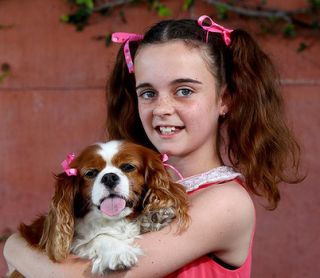Relationships
In What Ways Do Dogs and Their Owners Resemble Each Other?
Dogs and their owners look alike—it has to do with their eyes.
Posted November 20, 2013

People seem to have a great fascination with the possibility that their dogs might resemble them in some ways. The Internet is littered with amusing photos of people who seem to look very similar to their canine partner. The strange thing is, at least to conservative scientists like me, that there seems to be some truth to the popular belief that dogs and their owners look alike. I have even done some research which confirms this is true (click here to read about it). In fact, there is data suggesting that not only is there a physical resemblance between canines and their human partners, but they may resemble each other in terms of certain personality traits as well (read about it here).
Let us suppose that we accept the fact that dogs and their human caretakers might look alike, that still leaves a number of unanswered questions, such as in which ways do they resemble each other? Is it the overall shape of the head? Is it the set and size of the ears? Is it the shape of the mouth? Or perhaps might it be something about the eyes?
Dr. Sadahiko Nakajima of the Department of Psychological Science at Kwansei Gakuin University in Japan sent me an interesting piece of research* that has just been published in the journal Anthrozoos and which might provide an answer. In previous research people were asked to look at pairs of photographs (a dog and a person) and decide how similar they are. In this new piece of research 502 Japanese undergraduate students were presented with two sets of 20 dog-owner color photo pairs that had been printed on a test sheet. The people in the photos were Japanese males and females 20 to 60 years old, who were unknown to the participants. The dogs represented a number of different breeds. One sheet contained real pairs of owners and their dogs, while the other set were not really dog-owner pairs but rather dogs and people that had been randomly put together.
Each of the participants was told something like "This is a survey on dog-owner relationships and your task is to choose the set of dog owner pairs that physically resemble each other most closely." The participant then had to scan the two sheets and make an overall judgment as to which set of paired photos contained the individuals and dogs that look most similar. However the clever part of this research involved several manipulations of the photos. I will fold together the results of several experiments following the same method to give you a brief overall picture of what was found.
If we simply present the sets of photos observers are quite accurate in picking out the set which contains the real dog and owner pairs with 80 percent of participants the test subjects correctly choosing it. Next Dr. Nakajima altered the photos so that a black bar appeared obscured the owner's mouth (see the figure below). This had little effect on the ability of people to correctly select the set of photos containing the real dog-owner pairs (73 percent correct).
If the mouth is not important in determining the resemblance perhaps it is the eyes. So the next sets used pairs in which either the eyes of the human or that of the dog was obscured by a black bar. With the eyes covered the people judging the photo seemed to lose their ability to correctly discriminate between the set containing the real dog-owner pairs and they set containing randomly joined photos. If their judgments are no better than chance they should hover around 50 percent and they did (52 percent correct when the human's eyes were covered and 47 percent when the dog's eyes were covered).
Given the results so Dr. Nakajima could conclude that the eyes are important in our judgments between the similarity of a human and a dog so he then asked the question, what would happen if we ask people to make the similarity judgments when only the eyes are visible? This involved presenting sets of photos containing only the human and the dog's eyes side-by-side. Given only this information from the eyes people were nonetheless able to pick out the sets of true dog-owner pairs 74 percent of the time.
Black-and-white samples of the stimuli and a summary of the results are shown below.

So the conclusion seems to be that what makes dogs and their owners appear to look alike has something to do with the shape or other characteristics of their eyes. Other factors may play a role, but information from the eyes alone seems to carry a lot of the weight in determining how strongly we feel that an owner and his or her dog resemble each other.
Stanley Coren is the author of many books including: The Wisdom of Dogs; Do Dogs Dream? Born to Bark; The Modern Dog; Why Do Dogs Have Wet Noses? The Pawprints of History; How Dogs Think; How To Speak Dog; Why We Love the Dogs We Do; What Do Dogs Know? The Intelligence of Dogs; Why Does My Dog Act That Way? Understanding Dogs for Dummies; Sleep Thieves; The Left-hander Syndrome
Copyright SC Psychological Enterprises Ltd. May not be reprinted or reposted without permission
* Nakajima, S. (2013) Dogs and Owners Resemble Each Other in the Eye Region. Anthrozoos, 26, 551-556.




